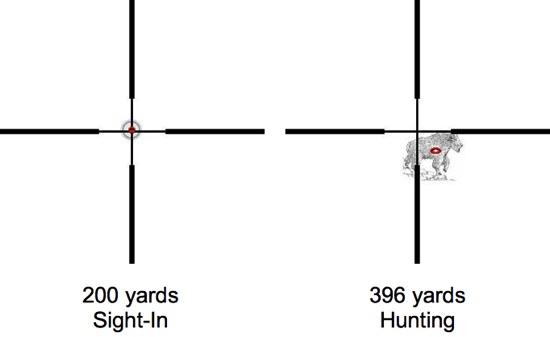How often have you stared at a ballistic table and wondered what the image in the scope should be to hit the target at distance? Here’s a utility that will help you when your rifle is zeroed at 200 yards and you have the drop at 500 yards.
Our Build Sight Pictures! utility uses the drop and drift at 500 yards to calculate the sight picture for intermediate ranges. One can use ballistic data from ammunition manufacturers to get those two chunks of information. One will not need a trajectory calculator* in this event!
DISCUSSION —
You are out hunting in the woods and spot an excellent animal ‘way out there.’ The quarry appears to be almost twice as far out as the target you used for sighting in. Stalking to within your point blank range is not always an option. You also know the rifle and load are reasonably flat shooting but don’t know where the crosshair should be to get the holdover and windage suggested by the trajectory table you memorized.
Today’s world offers a lot of optics choices for the informed hunter so it would seem that the classic ‘Kentucky Windage’ and ‘Tennessee Elevation’ are dated. Range estimation by eye or with stadia are challenging at best and suffer from accuracy loss as the distances go beyond 200-300 yards. The irony is that range estimation needs to be very precise to account for the steepening trajectories at the longer ranges to assure that the bullet stays within the vital zone.
One possible solution is the laser range-finder with or without trajectory modules. These tools can tell us to within a yard or so the precise range along with how many inches, minutes of angle, mils, etc. of elevation is needed to get the bullet to where it is supposed to go Compensating for wind drift, however, is still a problem.
Wind drift is comparable to the drop in magnitude at most distances of interest in big game hunting. Unfortunately, precise speed and direction averaged for the variations between shooter and target are not within the current state of the art. For this, we are left with hoping that the winds are steady (no gusts) and that the conditions between you and the target are pretty much the same was those you can measure or estimate.
The utility Build Sight Pictures! helps do a few significant chores for the shooter. First, one can get a pictorial representation of the holdover and offset needed to get the bullet into the vital zone out to nearly 600 yards. In other words, helping your skills of applying Kentucky Windage and Tennessee Elevation. Several different scope descriptions are available to give both a feel for the reticle and for the value of magnification for the shooting of interest. Second, the bullet impact point is illustrated by a 1 minute of angle high ellipse that has a width defined by a 40% wind and gust estimation uncertainty to give an indication of how far out a ‘very good shot’ can reasonably expect to hit the vital zone. Third, one can get a visual indication of the places the bullet might go if the wind estimate or gusts cause the effective wind to be 20% different than what the shooter estimates.
Taken together, the features give the hunter the ability to see what needs to be done to get a reliable hit and whether the conditions are just too unsettled for that shot to be taken ethically.
Equally important, the input has been simplified enough that one doesn’t have to be a ballistician to use the software! All you’ll need is a ballistics chart that gives the 500 yard drop for a 200 yard zero – found in several major ammunition catalogs. (Of course you can roll your own and build sight pictures using the more precise info!)
Go to Build Sight Pictures!
The default target image is a simple duplex sight viewing a mountain goat. Other targets and scope descriptions are selectable from the set-up page. Try running excursions of velocity and then repeating with wind speed at a fixed range. You’ll see that the target has to be moved in the scope to get the hit. Even more interesting, the uncertainty ellipse changes size and shape to give you an idea of whether you can ethically take the shot under those conditions!
* * * * *
* Some smart device apps also produce sight pictures, an ability not available when ShootersNotes.com was launched. A continuing benefit from our sight picture utilities is one can get a feel about how useful the imagery on one’s smart device might be. One can do an online search for “ballistic calculator apps” to see if one is of interest for continued exploration and field work.

 sending...
sending...